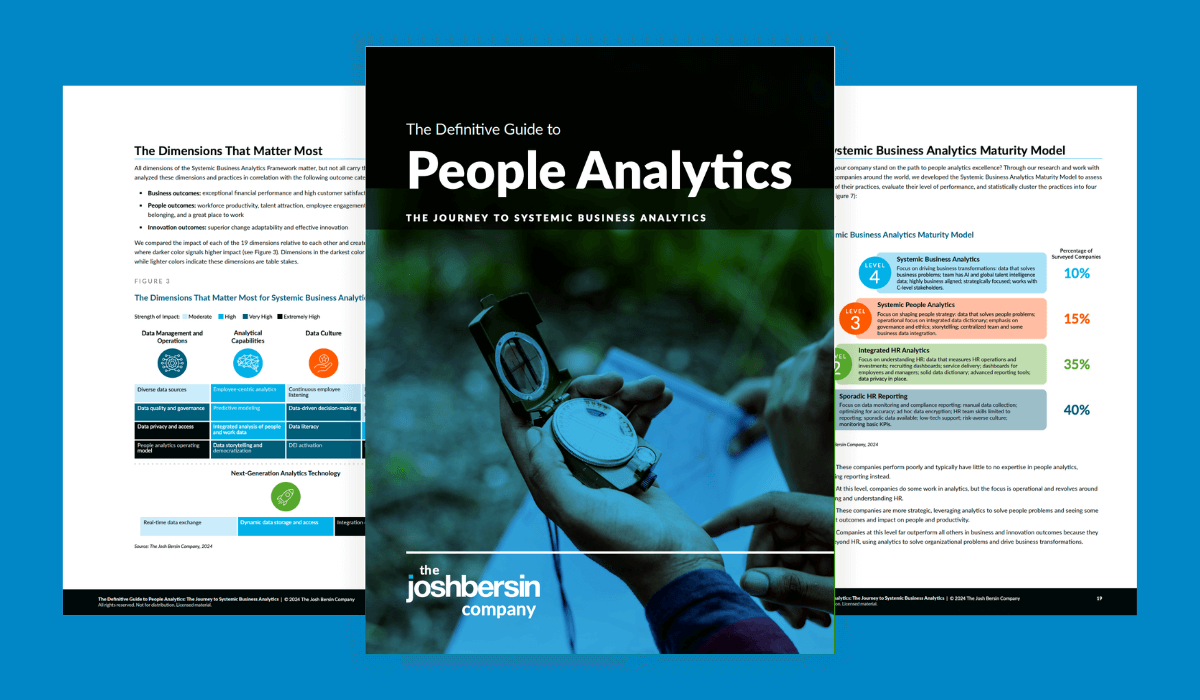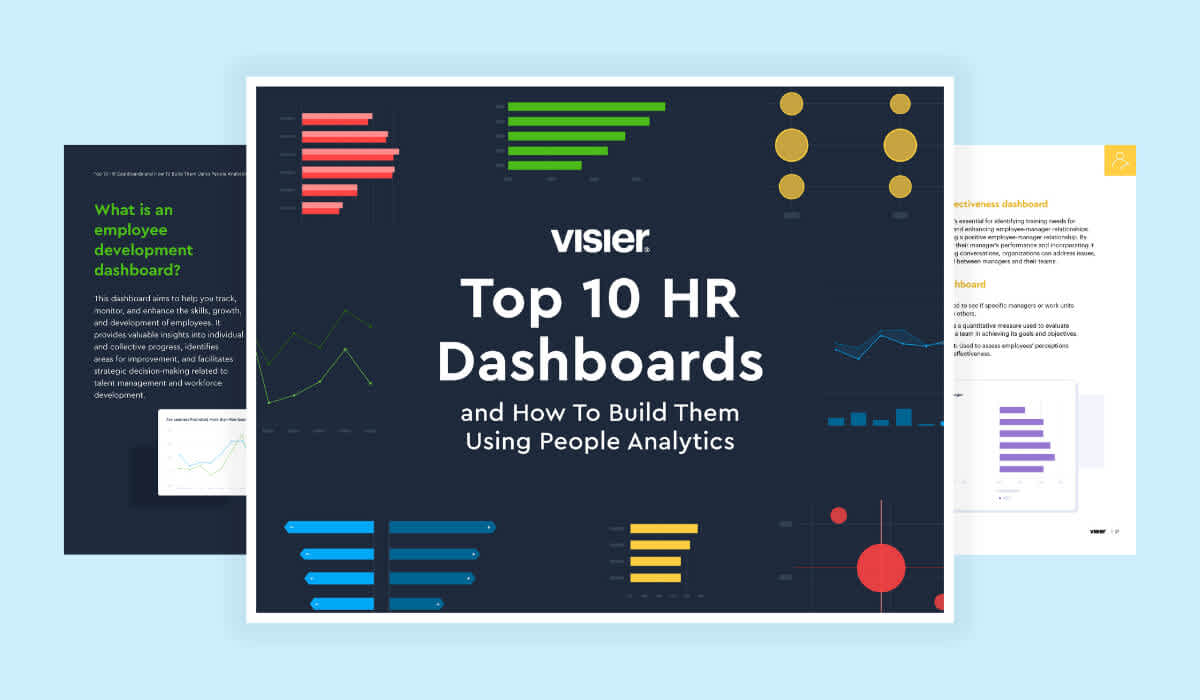Advancing People Analytics in Asia
While people analytics is gaining ground in Asia, the region still trails global leaders in adoption and maturity. Discover how Asian HR teams can catch up.

Asian organizations are behind the rest of the world in embracing the power of people analytics (PA) to drive workforce and business outcomes.
While the region has made recent progress in adopting modern analytics, its implementation lags in terms of maturity and systemic integration.
In this article, we explore the state of people analytics in Asia, compare it with global trends, and discuss how HR and people analytics professionals in the region can close this gap.
Adoption and maturity levels: a mixed picture
In Asia, the adoption of people analytics varies. Some organizations in countries like Singapore and Japan have seen recent rapid advances in workforce data usage. Others are still in the early stages of tracking basic HR metrics.
Research by Josh Bersin and Visier shows that many Asian organizations operate at Level 2 (Integrated HR Analytics), where the focus is on operational efficiency and dashboards. This contrasts with the Americas, where a significant portion of organizations are already at Level 4 (Systemic Business Analytics), integrating people data with business metrics to drive transformation.

The table below explains the levels of maturity in PA:
Level | Description |
Level 1: Sporadic HR Reporting | Focuses on basic HR reporting, often manual, with little integration or analysis. |
Level 2: Integrated HR Analytics | Uses dashboards and tools to measure HR efficiency and improve operational decisions. |
Level 3: Systemic People Analytics | Integrates HR and business data to shape people strategies and solve workforce issues. |
Level 4: Systemic Business Analytics | Drives business transformation by aligning people analytics with organizational strategy. |
Below, the illustration compares the people analytics maturity levels in Asia, EMEA, and the Americas, highlighting the percentage of organizations at each level. The chart shows how approximately 75% of organizations in the region are stuck at levels one and two of people analytics maturity.
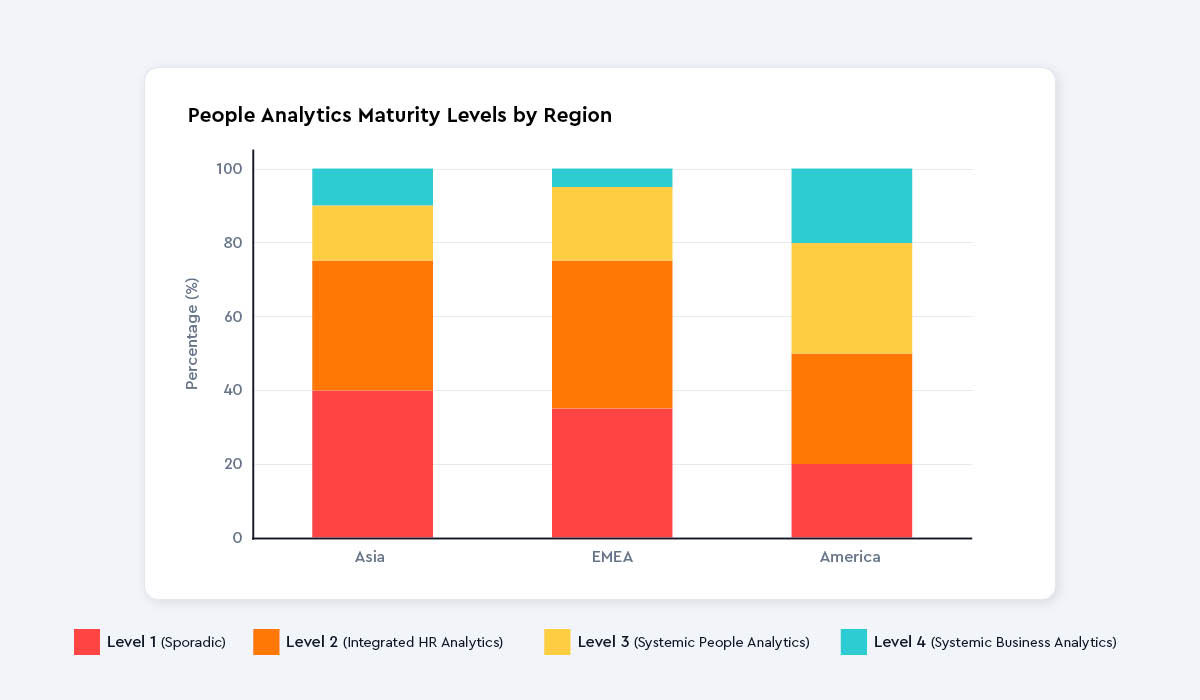
People Analytics Maturity Levels by Region
Priorities in people analytics: productivity over strategy
Asian organizations place a high emphasis on traditional metrics that enhance employee engagement. This includes tracking turnover, employee satisfaction, and workforce attendance. Strategic metrics like leadership pipeline strength and pay equity are less prioritized.
In comparison, the Americas excels at integrating strategic metrics, like promotion rates, into business decision-making. EMEA stands out for its focus on operational metrics, like retention and training hours.
The illustration below compares commonly tracked HR metrics across Asia, EMEA, and the Americas. The chart shows how in Asia, more attention is given to descriptive data as opposed to more diagnostic or predictive data.
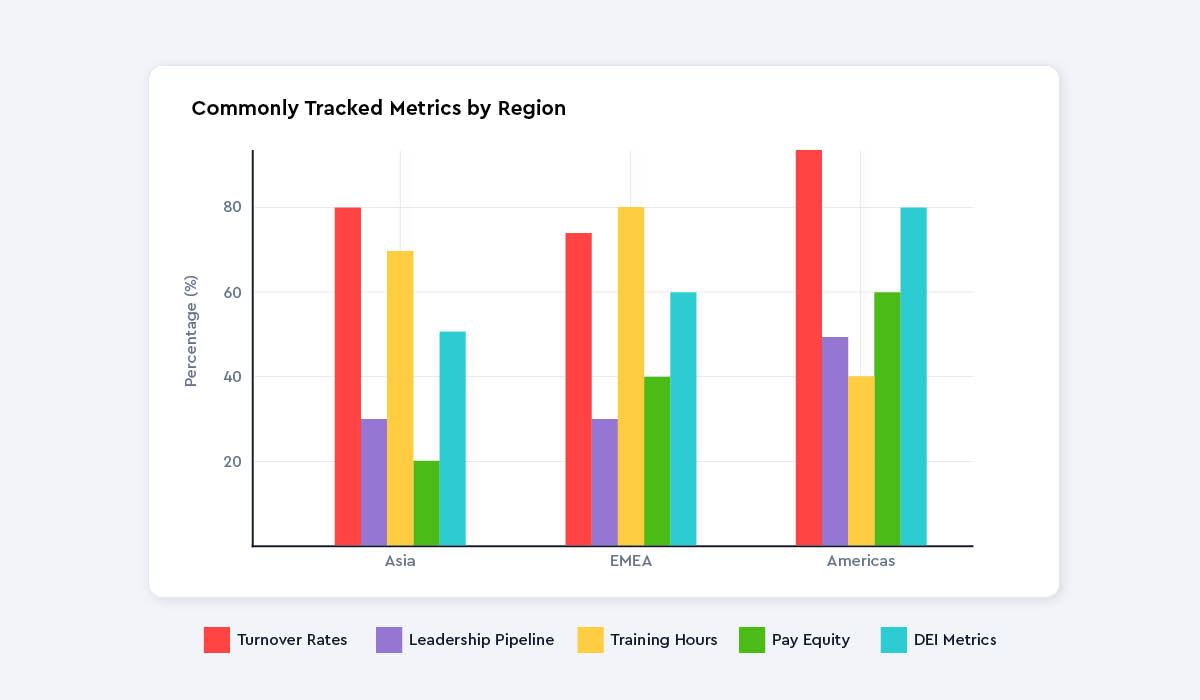
Commonly Tracked Metrics by Region
Technology use: Emerging global potential
Asia is making significant investments in AI and machine learning for workforce planning and talent development, especially in the technology and manufacturing industries.
However, these efforts are concentrated in larger organizations, while smaller companies lack the resources to adopt advanced analytics. The Americas lead in leveraging predictive and prescriptive analytics to anticipate workforce trends and support decision-making, with EMEA only showing moderate adoption of similar technologies.
The following illustration depicts a pie chart showing the percentage of organizations in Asia, EMEA, and the Americas using AI and advanced analytics tools. It’s clear that the region is behind the rest of the world in adopting AI for people analytics.
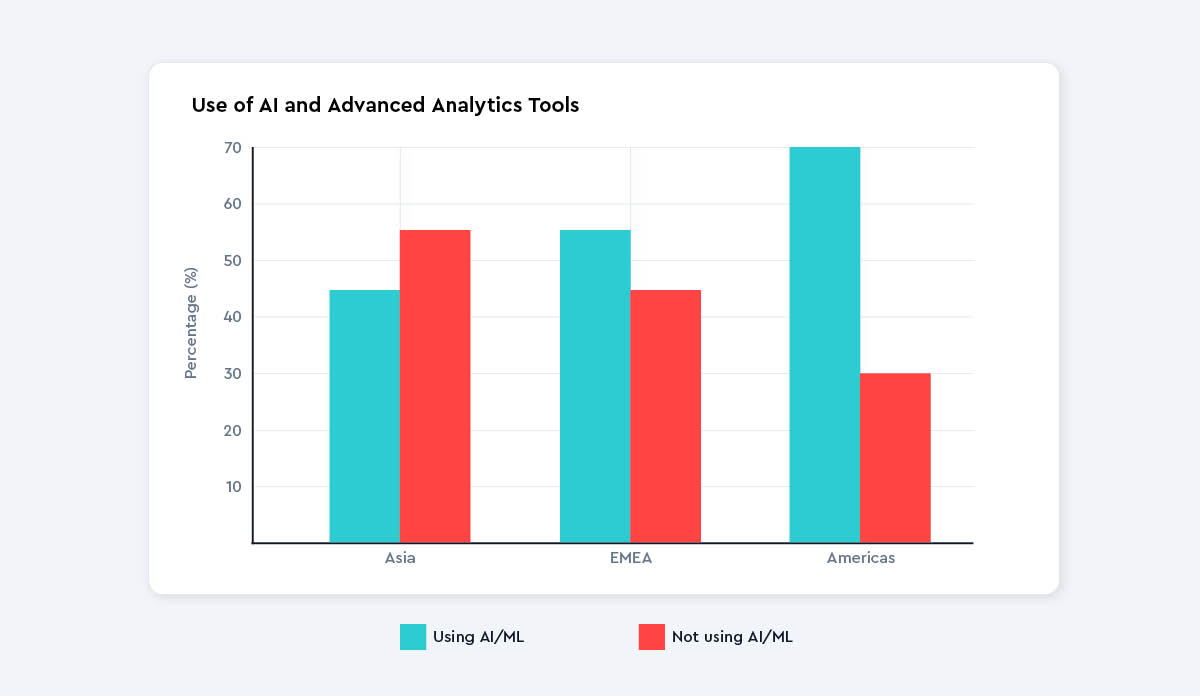
Use of AI and Advanced Analytics Tools
Challenges in scaling people analytics in Asia
Despite progress, many Asian organizations face challenges in scaling analytics, including:
Cultural resistance to data-driven decision-making, with many leaders relying on intuition over insights.
Fragmented data systems that make it difficult to integrate insights across departments.
Lack of standardization in data collection, limiting the effectiveness of analytics.
By comparison, the Americas struggle more with breaking down data silos, while EMEA faces challenges related to regulatory compliance.
The following illustration shows the top challenges in scaling people analytics for each region. It’s worth noting that in Asia, cultural resistance to data-driven decision making affects the progress made on data systems and lacks standardization.
Here, the need for diagnostic and predictive data isn’t yet seen as high (as it’s the case in the other regions). Hence, it’s crucial that HR leaders in the region adopt a data-driven mindset to improve decision-making.
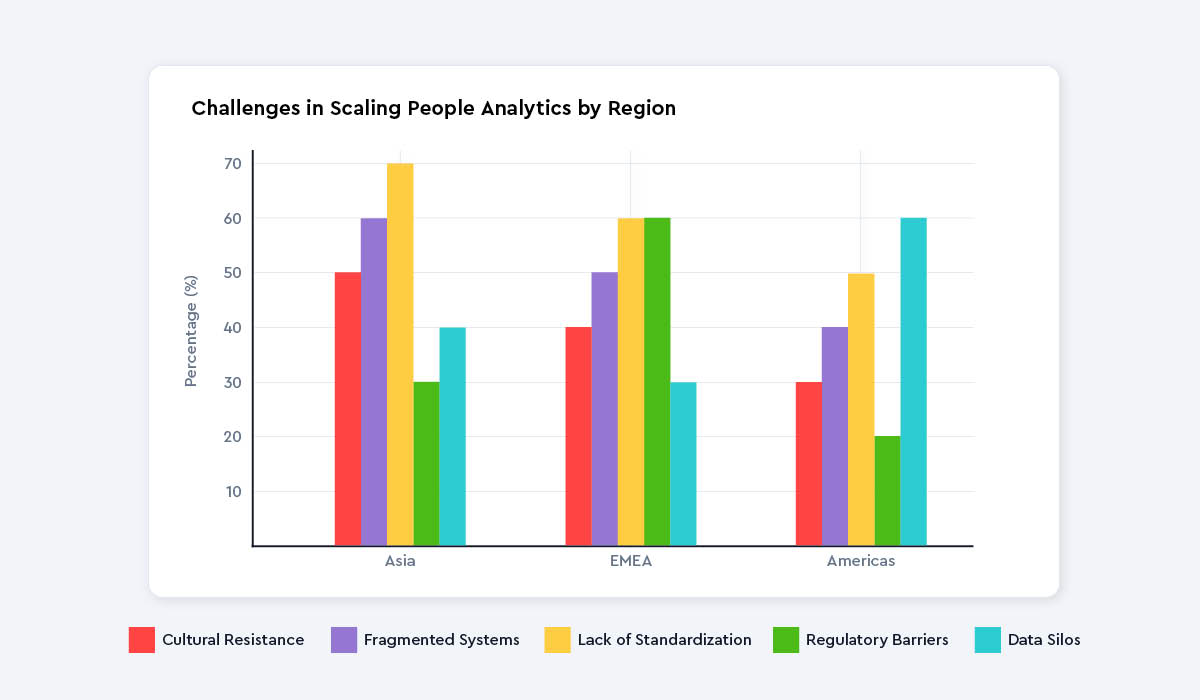
Challenges in Scaling People Analytics by Region
Opportunities for growth: Learning from global leaders
Asia has immense potential to close the gap by:
Focusing on strategic metrics (such as leadership development) to align people analytics with business outcomes.
Upskilling HR professionals in data literacy and storytelling, enabling them to make compelling business cases with analytics.
Investing in standardized systems that facilitate seamless data integration across HR and business functions.
Learning from the Americas’ experience with systemic analytics and EMEA’s success in compliance and governance will be essential for progress.
In the next illustration, you’ll see the projected growth of people analytics investments in Asia, with comparisons to the Americas and EMEA. It’s clear that the region feels a sense of urgency to catch up to the Americas in terms of People Analytics capabilities and capacity.
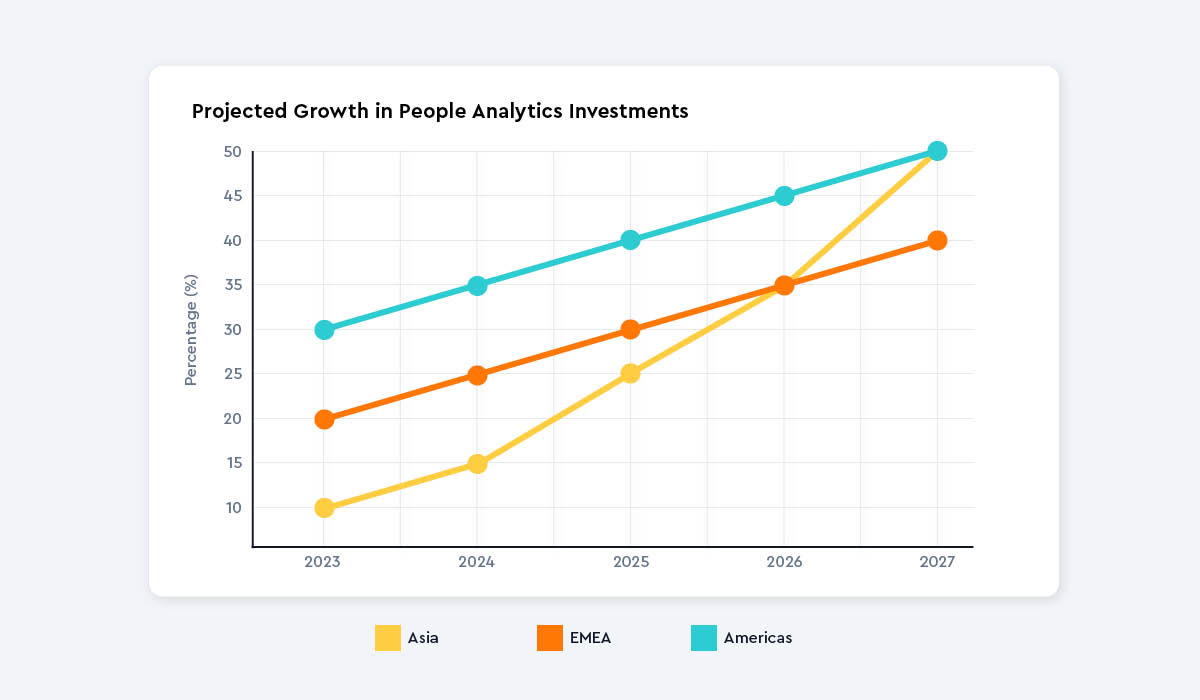
Projected Growth in People Analytics Investments
Impact on workforce and business outcomes
Organizations in Asia that effectively adopt people analytics are already seeing higher productivity (in the form of lower turnover) and better employee satisfaction.
However, achieving outcomes like improved innovation and strategic workforce planning requires deeper integration of analytics into business processes. The Americas, with their mature PA practices, excel at this (as illustrated below).
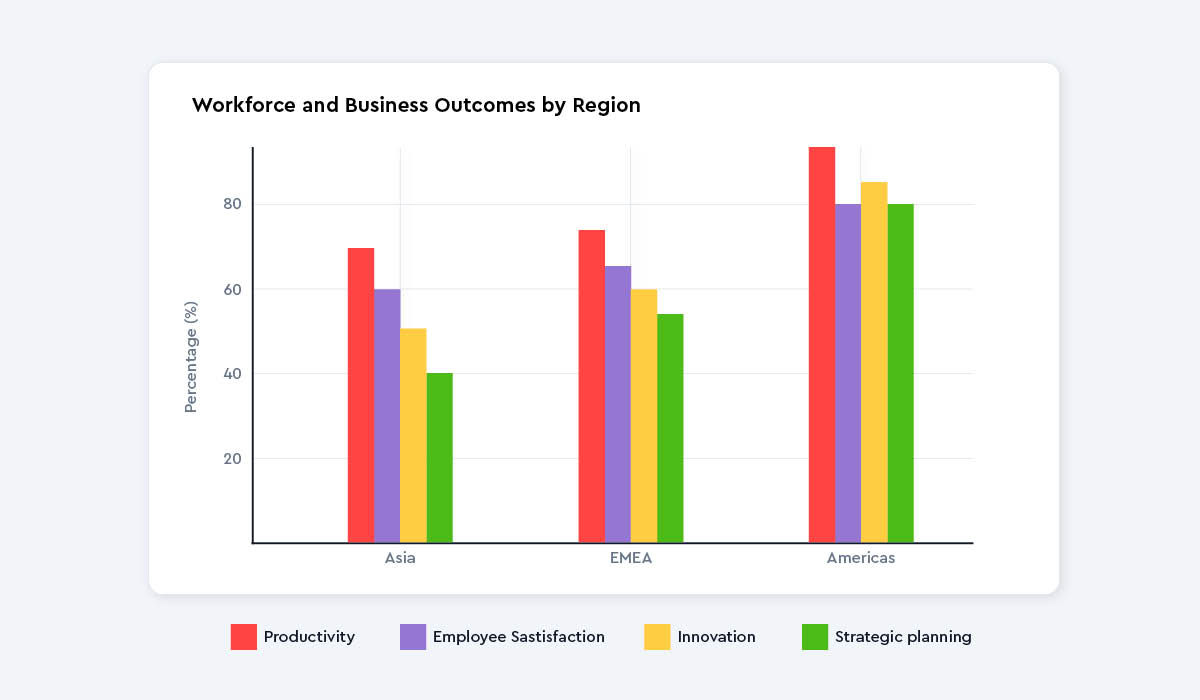
Workforce and Business Outcomes by Region
To catch up to the Americas, Asia will require a mindset shift towards more strategic objectives and expected outcomes from people analytics.

Asia sticks to its own journey toward global people analytics excellence
Asia has made remarkable progress in people analytics, but there’s still work to be done to catch up with the Americas.
By focusing on strategic metrics, improving data integration, increasing investments in the right tools, and upskilling HR teams, organizations in Asia can unlock the full potential of people analytics.
The strong expertise of HR professionals in the region, combined with the urgent need for innovative talent management due to workforce skill shortages and growth trends, creates a favorable environment for advancing people analytics in Asia. This progress will ultimately benefit both businesses and employees.
Visier empowers HR and business leaders in Asia with advanced people analytics, AI-driven workforce planning, and seamless data integration to drive strategic decisions. See how Visier can break down data silos so you'll unlock the full potential of people analytics for better business and workforce outcomes.


